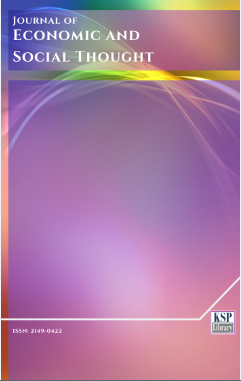The Performance Comparison of the Participation Banks Acting in Turkey via Grey Relations Analysis Method
Abstract
References
Abdul-Majid, M., Saal, D. S., & Battisti, G. (2010). Efficiency in Islamic and conventional banking: an international comparison. Journal of Productivity Analysis, 34(1), 25–43.
Aggarwal, R. K., & Yousef, T. (2000). Islamic banks and investment financing. Journal of Money, Credit and Banking, 93–120.
Akkas, A. (1996). Relative Efficiency of the Conventional and Islamic Banking System in Financing Investment. Unpublished Ph. d. Dissertation, Dhaka University.
Aktaş, M., & Avcı, T. (2013). Türkiye’de Katılım Bankacılığı ile Faize Dayalı Bankacılığın Etkinlik Açısından Karşılaştırılması. Finans Politik & Ekonomik Yorumlar, 50(576), 85–97.
Arslan, B. G., & Ergec, E. H. (2010). The efficiency of participation and conventional banks in Turkey: using data envelopment analysis. International Research Journal of Finance and Economics, 57, 156–168.
Beck, T., Demirgüç-Kunt, A., & Merrouche, O. (2013). Islamic vs. conventional banking: Business model, efficiency and stability. Journal of Banking & Finance, 37(2), 433–447.
Bumin, M. (2009). Türk Bankacılık Sektörünün Karlılık Analizi. Maliye Finans Yazıları, (84).
Çetin, A. C., & Bıtırak, İ. A. (2010). Banka Karlılık Performansının Analitik Hiyerarşi Süreci ile Değerlendirilmesi: Ticari Bankalar ile Katılım Bankalarında bir Uygulama. Uluslararası Alanya İşletme Fakültesi Dergisi, 2(2).
Chammas, G. (2006). Islamic finance industry in Lebanon: Horizons, enhancements & projections. Mémoire Professionnel, Ecole Supérieure Des Affaires, Beyrouth, Liban.
Doğan, M. (2013). Katılım ve Geleneksel Bankaların Finansal Performanslarının Karşılaştırılması: Türkiye Örneği. Journal of Accounting & Finance, (58).
Ecer, F. (2013). Türkiye’deki Özel Bankaların Finansal Performanslarının Karşılaştırılması: 2008-2011 Dönemi. Abant İzzet Baysal Üniversitesi Sosyal Bilimler Enstitüsü Dergisi.
El‐Gamal, M. A., & Inanoglu, H. (2005). Inefficiency and heterogeneity in Turkish banking: 1990–2000. Journal of Applied Econometrics, 20(5), 641–664.
El-Hawary, D., & Grais, W. (2003). Regulating Islamic financial institutions: the nature of the regulated (Vol. 3227). World Bank Publications.
Er, B., & Uysal, M. (2012). Türkiye’deki ticari bankalar ve katılım bankalarının karşılaştırmalı etkinlik analizi: 2005-2010 dönemi değerlendirmesi. Atatürk Üniversitesi İktisadi ve İdari Bilimler Dergisi, 26, 365–387.
Hasani, H., Tabatabaei, S. A., & Amiri, G. (2012). Grey relational analysis to determine the optimum process parameters for open-end spinning yarns. Journal of Engineered Fibers and Fabrics, 7(2).
Hussein, K. A. (2004). Banking Efficiency in Bahrain: Islamic vs Conventional Banks.
Islam, M. M., & Chowdhury, H. A. (2009). A Comparative Study of Liquidity Management of an Islamic Bank and a Conventional Bank: The Evidence from Bangladesh. Journal of Islamic Economics, Banking and Finance, 5(1), 89–108.
Khan, A. K. (2010). God, government and outsiders: The influence of religious beliefs on depositor behavior in an emerging market. Harvard, Cambridge.
Parlakkaya, R.-Ç., & Akten, S. (2011). Finansal rasyoların katılım bankaları ve geleneksel bankalar arasında bir tasnif aracı olarak kullanımı: Türkiye örneği. Ege Akademik Bakış, 11(3), 397–405.
Samad, A. (2004). Performance of Interest-free Islamic banks vis-à-vis Interest-based Conventional Banks of Bahrain. International Journal of Economics, Management and Accounting, 12(2).
Sayım, F., & Alakel, M. (2012). The Participation Banking And Its Comparison With Deposit Banking In The Turkish Finance Market. European Integration Studies, (5), 152–164.
Turkmenoglu, R. E. (2007). Katılım Bankacılığı Ve Türkiye’deki Finansal Yapı,.Unpublished MA Dissertation University, Kırıkkale.
Yayar, R., & Baykara, H. V. (2012). TOPSIS Yöntemi ile Katılım Bankalarının Etkinliği ve Verimliliği Üzerine Bir Uygulama. Business and Economics Research Journal, 3(4), 21–42.
DOI: http://dx.doi.org/10.1453/jest.v1i1.88
Refbacks
- There are currently no refbacks.
Journal of Economic and Social Thought - J. Econ. Soc. Thoug. - JEST - www.kspjournals.org
ISSN: 2149-0422
Editor: [email protected] Secretarial: [email protected] Istanbul - Turkey.
Copyright © KSP Library




